
737 MAX Flight Crew Operations Manual
Flight Management, Navigation -
Flight Management System
Operation
MN-FLT-OH-201
11.31.27
The path descent normally begins automatically at the calculated T/D point,
provided the MCP altitude is reset for the descent. If descent is not initiated by the
T/D, a path descent may not be achievable. At the T/D, the FMC commands idle
thrust and pitch to follow the descent path.
The descent complies with waypoint altitude restrictions by following the
calculated vertical path.
Note:
A path descent uses the target speed for planning purposes only. There is
no attempt to maintain the target speed during the idle portion of the
descent.
Note:
When in path descent, if actual airplane speed is less than the descent target
speed by a customized threshold amount loaded in the Loadable Defaults
Database, the FMC will transition to FMC SPD as the thrust mode. The
valid range for the threshold is 5 to 15 knots. The A/T mode returns to the
retard/arm mode when the airplane speed is then equal to the target speed.
Note:
When descending in VNAV PTH, the FCC will disengage VNAV and
switch to LVL CHG if actual speed becomes equal to or slightly less than
the minimum speed, denoted by the underspeed limiting symbol in the
MCP IAS/Mach window. This can also happen in turbulence or gusty
conditions when the minimum speed may momentarily increase due to G
loading. See section 4.20, Minimum Speed Reversion.
The CDU message DRAG REQUIRED is displayed if an unexpected tailwind
results in a significant increase in airspeed to maintain path. VNAV reverts to
VNAV SPD if a limit speed will be exceeded, with COMMON VNAV.
A path descent must be initiated while within the allowable cross–track error for
LNAV, however LNAV may be disengaged during descent while remaining in the
path mode. VNAV will remain in path regardless of cross–track.
March 1, 2021





































